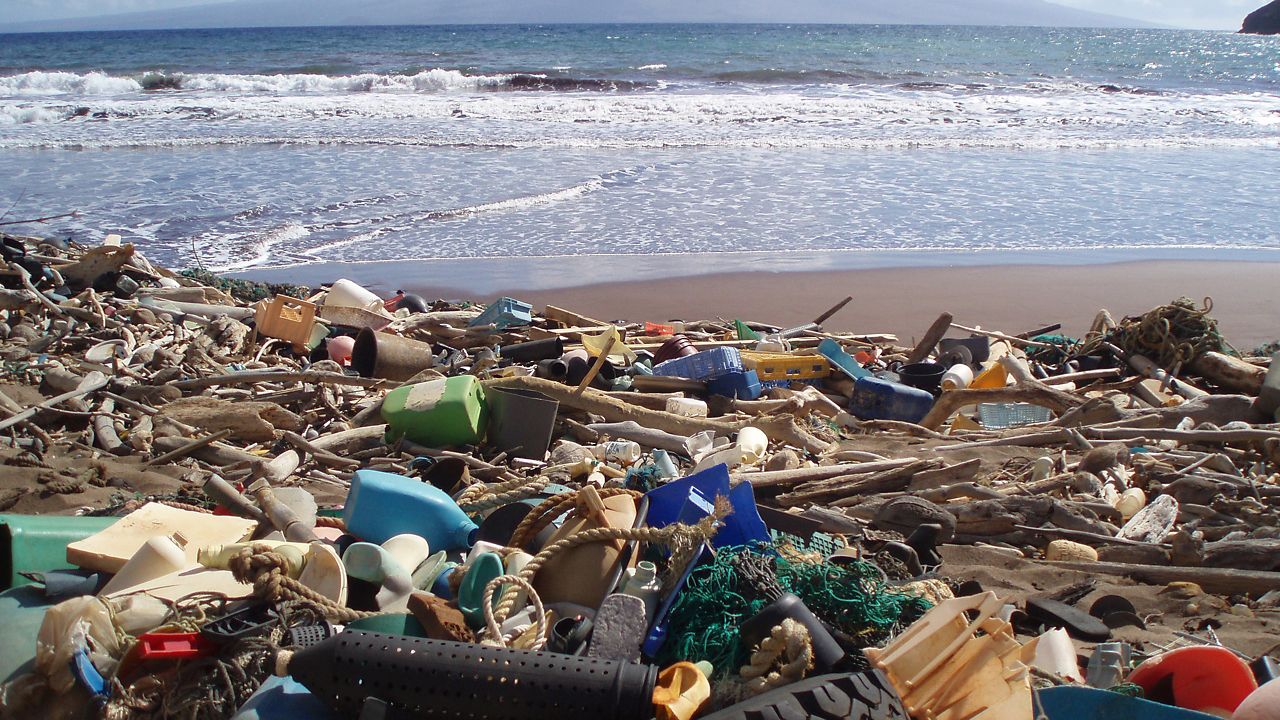Plants and animals normally found along the coastline are now traveling hundreds of miles into the open ocean aboard plastic pollution — and creating new communities.
They were discovered in the North Pacific Subtropical Gyre, commonly referred to as the “Great Pacific Garbage Patch.” That’s what two oceanographers from the University of Hawaii at Manoa’s School of Ocean and Earth Science and Technology have written in “Nature Communications,” an open access journal featuring research that fall under the natural sciences, stated a UH news release.
The commentary by SOEST scientists Nikolai Maximenko and Jan Hafner reports coastal species growing on trash, calling them “neopelagic” communities. “Neo” means “new” and “pelagic” refers to the open ocean. The concept of plastic creating a habitat for a “new open ocean” community — and somehow finding food — is something new to marine scientists.
The open ocean had long been considered a physical barrier for the spread of coastal marine species, stated the article. However, this was found to no longer be the case because of plastic debris.
The thought now is how these “coastal rafters” could disrupt the ocean ecosystem with the ocean’s own native species already colonizing floating debris. The new finding also opens the door to coastal rafters “invading” new coastlines.
The possibility of coastal species using plastic to survive in the ocean occurred after the 2011 Tohoku, Japan earthquake and tsunami. Scientists discovered nearly 300 species “had rafted all the way across the Pacific on tsunami debris over the course of several years,” stated the release. But until now, confirmed sightings of these neopelagic communities were rare. In addition, there was no evidence that the species could reproduce.
Maximenko and Hafner created models predicting where plastic would most likely concentrate in the North Pacific Subtropical Gyre. They then shared their findings with Ocean Voyages Institute, a nonprofit that specializes in ghost-net recovery and marine cleanup.
Ocean Voyages Institute founder and executive director Mary Crowley and her team have set a world record for “removing over 170 tons of plastic debris from the North Pacific Subtropical Convergence Gyre,” according to its website. Of that amount, the group collected 103 tons in 2020 during a 48-day expedition taken during the height of the COVID-19 pandemic.
Samples were collected from the debris and sent to the Smithsonian Environmental Research Center Marine Invasions Lab. Lead author of the article, Linsey Haram, discovered coastal species such as anemones, “hydroids” and shrimp-like amphipods thriving on the plastic.
“The issues of plastic go beyond just ingestion and entanglement,” said Haram. “It’s creating opportunities for coastal species’ biogeography to greatly expand beyond what we previously thought was possible.”
There are five garbage patches in the worlds’ oceans formed by rotating ocean currents called “gyres,” according to the NOAA Marine Debris Program. This is where marine debris — litter, fishing gear, plastics, microplastics and more — collect as they’re pulled in by the circulating gyre. In varying sizes, the five gyres are located in the Indian Ocean, two are in the Atlantic Ocean and two are in the Pacific Ocean. The Great Pacific Garbage Patch sits between Hawaii and California; it’s estimated to measure twice the size of Texas.
The NOAA states these garbage patches are more than just an “island” of trash. The patch spreads a wide distance across the ocean's surface and reaches all the way to the ocean floor. Debris size ranges from large fishing nets to microplastics that are smaller than five millimeters in size. The dangers they cause are injuring or killing marine life, being ingested by animals and transporting non-native species to new environments that could cause disruption.
Because the garbage patches aren’t visible to the general public, there is a lack of awareness of how dire the situation is.
“I’m an avid surfer, waterman, diver on Maui, and I really wasn’t aware of the scope of this giant problem,” said Jackson McMuldren, photographer/videographer, who accompanied the 48-day Ocean Voyages Institute expedition that removed 103 tons of marine debris from the North Pacific Subtropical Convergence Gyre. “It was really frightening how much plastic was out there. When you look off the boat there would just be clouds of tiny pieces, smaller than your fingernail, and then consumer plastics, marine debris, ghost nets from fishing gear.
“And when we’d dive on the nets, we’d find turtles, fish, giant tuna; they’re all dead, stuck in the nets so it was really disheartening. But the work that Mary Crowley and Ocean Voyages Institute is doing to go out there and collect these nets, helping to solve the problem ... it’s a monumental problem. You realize that when you’re out there because there’s plastic everywhere.”
“The ocean is a source of health for us as a planet and for us as human beings,” stated Crowley in a video released by Ocean Voyages Institute. “We have to take care of it and have a healthy habitat for ocean creatures. To do this, we have to change some habits, we have to have much better waste management, and we have to, right now, be doing lots of ocean clean up.”
The authors predict that the world’s continuing dependence on plastics combined with more frequent and much more fierce storms because of climate change will push even more plastic out into the open ocean. This could soon transform life on shore and in the sea.



